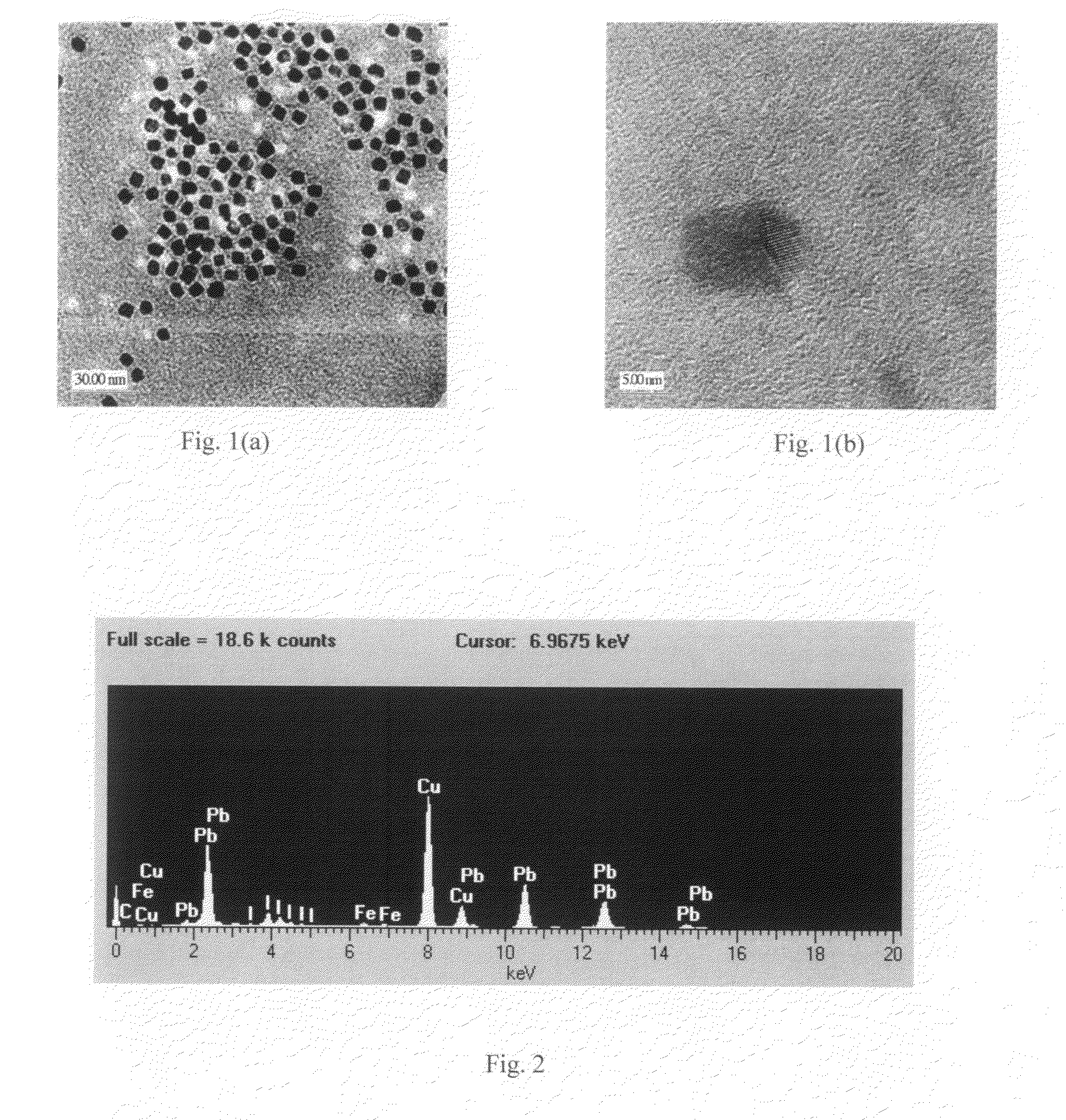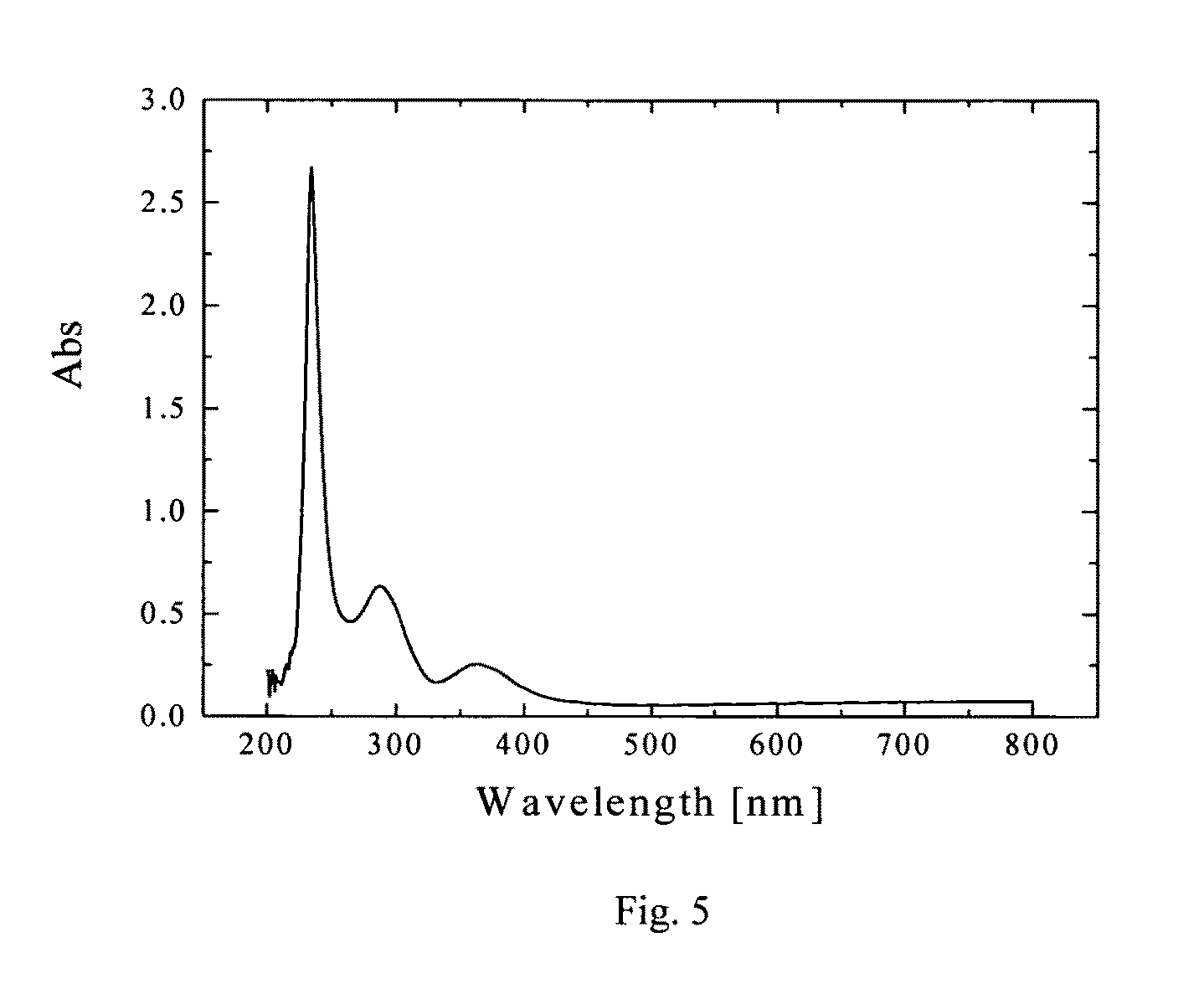Lead-iodide-based scintillator materials
a technology of lead iodide and scintillator, which is applied in the direction of iodine oxygen compounds, halogen oxides/oxyacids, instruments, etc., can solve the problems of slow or low radiative efficiency, undoped semiconductors have rarely been used as scintillators, and achieves a higher signal-to-noise ratio, the effect of improving the signal-to-noise ratio of the tomographic image and reducing the dose dose dos
- Summary
- Abstract
- Description
- Claims
- Application Information
AI Technical Summary
Benefits of technology
Problems solved by technology
Method used
Image
Examples
example 1
A. Synthesis of Lead-Iodide-Based Nanocrystals and Microcrystals
[0040]One synthesis procedure involves dissolution of bulk lead iodide in a coordinating solvent tetrahydrofuran (THF), subsequent re-crystallization with the addition of anhydrous methanol, and addition of dodecylamine (DDA) to obtain solvent-stabilized lead iodide NCs. The THF, anhydrous methanol, and DDA were purchased from Sigma Aldrich and used directly. A synthesis procedure also is described in [Finlayson, 2006], which was used for synthesis of PbI2 NCs.
[0041]In a typical procedure, 100 mg of high purity (99.999%) lead (II) iodide powder is initially dissolved in 15 mL of THF under continuous stirring at RT (room temperature) and under atmospheric pressure. The above conditions are important, since solubility is a strong function of temperature and pressure. Subsequently, the solution is sonicated in centrifuge tubes in order to obtain a saturated solution. Then, to remove any insoluble suspension still present, ...
example 2
A. Second Synthesis of Lead-Iodide-Based Nanocrystals (PbIOH)
[0065]The synthesis procedure for PbIOH nanocrystals was a modification of PbClOH synthesis reported by H. Zhang, M. Zuo, G. Li, S. Tan and S. Zhang, “Laurionite nanowires and nanoribbons: rapid mechanochemical solution synthesis and optical properties”, Nanotechnology 16, pp. 3115-3119 (2005).
[0066]During a typical synthesis procedure, 0.461 g (˜1 mmol) of lead (II) iodide (PbI2) powder and 3 ml of 0.1 M sodium hydroxide (NaOH) solution were put into a mortar and ground with a pestle for 2 min at room temperature. The solution was collected and alternately centrifuged with deionized water, then centrifuged with ethanol, three times. The remaining yellowish samples were collected and stored in ethanol. An alternative method of synthesizing iodolaurionite was successfully accomplished by substituting potassium hydroxide (KOH) for the sodium hydroxide.
[0067]High-resolution TEM analysis revealed nanocrystals 3-15 nm in diamet...
example 3
A. Third Synthesis of Lead-Iodide-Based Nanocrystals (Pb3O2I2)
[0068]The synthesis procedure for Pb3O2I2 nanocrystals was a modification of Pb3O2Cl2 synthesis reported by K. Lozano, C. Hernandez, T. W. Petty, M. B. Sigman, B. Korgel, “Electrorheological analysis of nano laden suspensions”, Journal of Colloid and Interface Science 297, pp. 618-624 (2006).
[0069]In this synthesis, 0.332 g of high purity (99.999%) lead (II) iodide (PbI2) powder was added to 32 ml of deionized water. 25 ml of chloroform (CHCl3) with 0.17 g sodium octanoate (NaOOC(CH2)6CH3) were then added to the aqueous PbI2 solution forming two phases—an aqueous phase and a cloudy organic phase. The aqueous phase was then separated and discarded. 0.5 ml of ethylenediamine (C2H8N2) was added to the remaining organic solution. Evaporation of the organic solvent gave an opaque grayish-white solid, which served as the nanocrystal precursor. The precursor was heated in air for 60 min at 170° C. A dark grey solid was formed, a...
PUM
 Login to View More
Login to View More Abstract
Description
Claims
Application Information
 Login to View More
Login to View More - R&D
- Intellectual Property
- Life Sciences
- Materials
- Tech Scout
- Unparalleled Data Quality
- Higher Quality Content
- 60% Fewer Hallucinations
Browse by: Latest US Patents, China's latest patents, Technical Efficacy Thesaurus, Application Domain, Technology Topic, Popular Technical Reports.
© 2025 PatSnap. All rights reserved.Legal|Privacy policy|Modern Slavery Act Transparency Statement|Sitemap|About US| Contact US: help@patsnap.com



